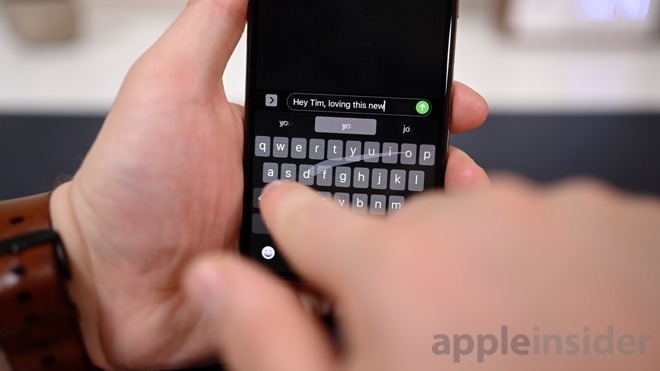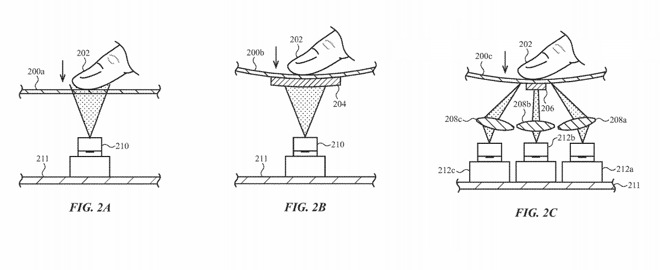Apple looking at Face ID laser tech to improve iPad & iPhone typing
Displays in a future iPad or iPhone could use lasers to detect touch, with the employment of VCSEL sensors and other technologies potentially monitoring the deflection of the screen to determine levels of 3D touch or to provide a more improved typing experience.

Apple's new QuickPath keyboard in iOS 13 and iPadOS
Current touchscreen technologies used in devices, like the iPhone and iPad among others, can use a wide array of techniques to detect when the user is touching the screen, or doing so with force. Existing methods include capacitive sensing, resistive sensing, ultrasonic sensing, and optical sensing.
With optical sensing in particular, the technology can be used to determine the deflection of the display from a finger press or pressure from a stylus. In a patent application published by the US Patent and Trademark Office on Thursday, Apple suggests it could improve upon existing methods.
In the filing titled "Self-Mixing Interference Based Sensors for Characterizing Touch Input," Apple proposes the use of vertical-cavity surface-emitting lasers (VCSELs) to monitor the display for touch inputs.
Each VCSEL emits a beam of "coherent light" towards the surface being monitored, which is reflected and mixed in with other coherent light beams at a variety of angles into other sensors. The number of angles is important, as the deflection of the display surface can alter the angle of reflection, which means the reception of specific light beams by other sensors can inform the system of how much deflection there is.
The system can be improved further still, by performing spectrum analysis on measured detections of multiple sensors to determine a speed of movement and the direction of movement. This can include reading multiple harmonic frequencies at different stages, which can also infer movement.

An example of VCSELs being used to determine a press and deflection of a surface
The measuring of the deflection is important, as it tells the system how hard the user is pressing down on a specific point of the display. While this has immediate applications in areas like 3D Touch, which used the amount of pressure on a display to determine what level of options to provide to the user, there are other ways it can be employed.
Software keyboards on touchscreens currently detect touch events, be they distinct pressing of specific areas of a display or swiping motion between keys as used in some versions. By detecting the level of deflection, it is feasible for a touchscreen keyboard to only accept the tapped input at a certain level of pressure, while disregarding lighter touches.
In theory this could allow the user to gently rest their fingers on the keyboard in a similar way to a physical keyboard for touch typing, safe in the knowledge their fingers won't trigger spurious key presses until they intentionally type and pass a pressure-based equivalent of a keyboard mechanism's "actuation" point.
Apple files numerous patent filings on a weekly basis, but while the applications do not necessarily result in the concepts being used in a future product or service, they do inform of areas of interest for Apple's research and development efforts.
VCSELs are already an important area of interest for Apple, with the technology used to power the iPhone's TrueDepth camera array, as well as showing promise in self-driving vehicle applications under "Project Titan."
Apple made a $390 million investment in Finisar as part of its Advanced Manufacturing Fund strategy in 2017. A producer of VCSELs, the investment in the US firm gives Apple a larger supply of the components for future use, as well as giving Finisar more resources to develop alternate ways to use the technology.

Apple's new QuickPath keyboard in iOS 13 and iPadOS
Current touchscreen technologies used in devices, like the iPhone and iPad among others, can use a wide array of techniques to detect when the user is touching the screen, or doing so with force. Existing methods include capacitive sensing, resistive sensing, ultrasonic sensing, and optical sensing.
With optical sensing in particular, the technology can be used to determine the deflection of the display from a finger press or pressure from a stylus. In a patent application published by the US Patent and Trademark Office on Thursday, Apple suggests it could improve upon existing methods.
In the filing titled "Self-Mixing Interference Based Sensors for Characterizing Touch Input," Apple proposes the use of vertical-cavity surface-emitting lasers (VCSELs) to monitor the display for touch inputs.
Each VCSEL emits a beam of "coherent light" towards the surface being monitored, which is reflected and mixed in with other coherent light beams at a variety of angles into other sensors. The number of angles is important, as the deflection of the display surface can alter the angle of reflection, which means the reception of specific light beams by other sensors can inform the system of how much deflection there is.
The system can be improved further still, by performing spectrum analysis on measured detections of multiple sensors to determine a speed of movement and the direction of movement. This can include reading multiple harmonic frequencies at different stages, which can also infer movement.

An example of VCSELs being used to determine a press and deflection of a surface
The measuring of the deflection is important, as it tells the system how hard the user is pressing down on a specific point of the display. While this has immediate applications in areas like 3D Touch, which used the amount of pressure on a display to determine what level of options to provide to the user, there are other ways it can be employed.
Software keyboards on touchscreens currently detect touch events, be they distinct pressing of specific areas of a display or swiping motion between keys as used in some versions. By detecting the level of deflection, it is feasible for a touchscreen keyboard to only accept the tapped input at a certain level of pressure, while disregarding lighter touches.
In theory this could allow the user to gently rest their fingers on the keyboard in a similar way to a physical keyboard for touch typing, safe in the knowledge their fingers won't trigger spurious key presses until they intentionally type and pass a pressure-based equivalent of a keyboard mechanism's "actuation" point.
Apple files numerous patent filings on a weekly basis, but while the applications do not necessarily result in the concepts being used in a future product or service, they do inform of areas of interest for Apple's research and development efforts.
VCSELs are already an important area of interest for Apple, with the technology used to power the iPhone's TrueDepth camera array, as well as showing promise in self-driving vehicle applications under "Project Titan."
Apple made a $390 million investment in Finisar as part of its Advanced Manufacturing Fund strategy in 2017. A producer of VCSELs, the investment in the US firm gives Apple a larger supply of the components for future use, as well as giving Finisar more resources to develop alternate ways to use the technology.

Comments
Several of us were initially confused about what the Advance Manufacturing Fund actually was. It does not dole out grants as can best be determined, instead intended to be paying for product in an advance against production.
The overall point of this article is totally accurate tho IMO. Apple is showing a lot of interest in VCSEL's and eyeing an expansion of their use. Good catch.
In the case of manufacturing, there is usually a quid pro quo from the funding provider, ie a "grant", that the money will be used upfront for process or efficiency improvements, ie new equipment that provides cost benefits and/or quality benefits, while meeting the funding provider's output volume. That the funding will ultimately be a payment for the output is again not unusual.
It isn't passive funding, and from the standpoint of the manufacturing partner, it provides an investment in the manufacturing process, though indeed, not an investment in the company.
I've received both: An advance order, like a payment from an Advanced Manufacturing Fund, for specialty graphics which required the purchase of a certain type of press for a specific client's needs ((Bombardier/Evinrude/Johnson). As it was not a product I would typically offer we agreed to an advance payment in order to fund the purchase of that press and ramp up raw material orders. You would like to call that a grant but it is not...
...and also the more typical "deposits" before ordering a specialized material for a client or committing to an expensive project. Both serve essentially the same purpose, committing the customer as a partner on a project and/or enabling the purchase of expensive but necessary equipment required to fill a customer's needs that would not otherwise be purchased, paying for it with eventual profits from the committed product sales.
(Reuters) - Apple Inc said on Wednesday it had awarded $390 million to optical components maker Finisar Corp to boost production of laser chips that power iPhone X’s features such as Face ID, Animoji and portrait mode photos.
The iPhone maker has committed to spend at least $1 billion through its Advanced Manufacturing Fund in U.S.-based companies to support high-tech manufacturing. The company had awarded $200 million to Gorilla Glass maker Corning Inc in May.
However, Finisar Corp clarified that Apple’s funding was not a debt or equity investment in the company.
Finisar’s shares, which rose as much as 30 percent on Apple’s announcement, pared gains to trade up 22 percent following the clarification.
"The amount referred to by Apple represents anticipated future business between the companies over a period of time," Finisar said in a filing.
The company will use the grant to reopen a 700,000-square-foot plant in Sherman, Texas to ramp up production of laser chips called vertical-cavity surface-emitting lasers, or VCSELs.
"Innovation in the heart of Texas! Proud to team up with @Finisar, the latest recipient from our Advanced Manufacturing Fund," Apple Chief Executive Tim Cook said in a tweet.
The lasers will also be used for 3D sensors in AirPods and Apple’s wireless headphones.
Finisar is expected to ship products from the plant starting in the second half of 2018.
Apple said it would buy 10 times more VCSELs than were previously made worldwide in the fourth quarter, compared with a year earlier.
Not a word about prepayment, though their is likely a quid pro quo on cost reductions/volume.
Apple is not taking an equity stake in Finisar, nor does the award represent a debt investment of any type. Based on the wording It looks like the $390 million is for all intents a prepayment for future purchases of Finisar sensing components (VCSELs).